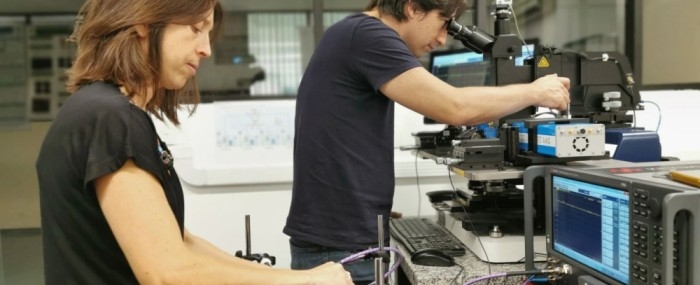

Companies and research groups can use the infrastructure at the University of São Paulo to obtain measurements and develop equipment, circuits and devices that operate at frequencies up to 110 gigahertz (photo: Daniel Gonçalves)
Companies and research groups can use the infrastructure at the University of São Paulo to obtain measurements and develop equipment, circuits and devices that operate at frequencies up to 110 gigahertz.
Companies and research groups can use the infrastructure at the University of São Paulo to obtain measurements and develop equipment, circuits and devices that operate at frequencies up to 110 gigahertz.

Companies and research groups can use the infrastructure at the University of São Paulo to obtain measurements and develop equipment, circuits and devices that operate at frequencies up to 110 gigahertz (photo: Daniel Gonçalves)
By Elton Alisson | FAPESP Innovative R&D – The Millimeter Wave Center, recently unveiled at the University of São Paulo’s Engineering School (POLI-USP) in Brazil and developed with FAPESP’s support, is equipped to enable companies and research groups to obtain measurements and develop equipment, circuits and telecommunication devices designed to operate at frequencies up to 110 gigahertz (GHz).
The extremely high frequencies on the radio spectrum band between 30 GHz and 300 GHz are known as millimeter waves and will be used in the fifth generation (5G) of wireless communication networks.
“The truly novel element in 5G is the use of the 30 GHz frequency band in addition to all the frequencies used in other data transmission protocols,” Ariana Lacorte Caniato Serrano, a professor at POLI-USP and coordinator of the Millimeter Wave Center, told FAPESP Innovative R&D.
5G networks are already running in some US cities and parts of China, South Korea and the UK. Brazilian operators plan to begin offering 5G services in 2021.
At these extremely high frequencies, 5G networks will be able to transport very large amounts of data at speeds up to 20 times faster than those of 4G, the current generation, with far shorter latency and download times. Real-time video transmission will be feasible without interruptions and with a higher resolution than in the past.
“Higher frequencies result in a significant increase in bandwidth for data transmission,” Serrano said. “More data can be transmitted in real time and with greater precision using 5G technology.”
The numbers of machines and devices that can be connected to 5G networks are also far larger than those for 4G, thus enabling the expansion of the Internet of Things, artificial intelligence, robotics and machine learning.
Industry will be most positively impacted by the advent of 5G, which will help accelerate manufacturing processes and make factories smarter. Healthcare services will also benefit, as will the automotive industry due to the feasibility of developing secure radar systems for self-driving cars, according to experts in the field.
“Forthcoming generations of telecommunication systems will increasingly use high frequencies to boost data transmission speeds to hundreds of gigabits per second [Gbps],” Serrano said. “The Millimeter Wave Center’s remit is to contribute to the development of devices, equipment and systems that operate in this frequency spectrum.”
Research and development
The Center is equipped to perform the electrical characterization of passive, active and integrated circuits, as well as develop devices such as cellular antennas.
In the case of 5G networks, for example, the high-frequency waves used do not travel as far as the longer waves used at lower frequencies and do not easily penetrate buildings, glass or other physical obstacles. For this reason, operators must install many more cellular base stations to offer the same coverage as that obtained with 4G.
The Center has a vector network analyzer to measure the power of the signals transmitted by base stations. This device was purchased for USD $600,000 with funding awarded by FAPESP’s Multi-User Equipment Program.
The Center has an anechoic chamber to analyze the propagation of millimeter-wave antenna signals using three-dimensional (3D) radiation diagrams. The chamber was built by researchers at POLI-USP with funding from FAPESP and donations to the “Friends of POLI” fund.
“The Center lets users measure and characterize materials, sensors and radars, for example. They can also develop new devices allied to 3D electromagnetic simulation based on cutting-edge software,” Serrano said.
Through a project also supported by FAPESP, researchers affiliated with the Center developed radio-frequency microelectromechanical systems on a copper nanowire substrate.
Known as RF MEMS, these system configurations are similar to miniaturized printed circuit boards with high-density capacitors and passive devices mounted on the same substrate for millimeter-wave applications, such as use in transformers that operate at 50 GHz.
“Transformers typically operate at up to a few gigahertz. With this technology, we can produce transformers using the microelectronic processes currently deployed to fabricate computer chips,” said Gustavo Pamplona Rehder, a professor at POLI-USP and principal investigator for the project.
Republish
The Agency FAPESP licenses news via Creative Commons (CC-BY-NC-ND) so that they can be republished free of charge and in a simple way by other digital or printed vehicles. Agência FAPESP must be credited as the source of the content being republished and the name of the reporter (if any) must be attributed. Using the HMTL button below allows compliance with these rules, detailed in Digital Republishing Policy FAPESP.





